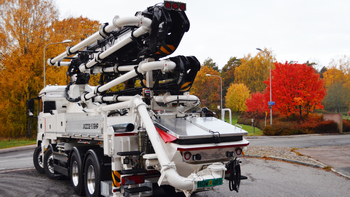
Concrete pumps are essential in modern construction, allowing for the efficient and precise placement of concrete for several tasks. From towering skyscrapers to intricate foundation work, the versatility of concrete pumps is unmatched. The various concrete pump types that are available, their uses, and the benefits they offer to the construction sector are all covered in this guide.
Boom Concrete Pumps
Boom concrete pumps, frequently referred to as truck-mounted concrete pumps, include an articulated and extendable robotic arm, or “boom,” for delivering concrete to awkward or high-up areas. These pumps are mounted on trucks, allowing them to be easily transported and set up on-site. Boom pumps are particularly effective for large-scale projects like high-rise buildings, bridges, and commercial structures.
 Trailer-Mounted Concrete Pumps
Trailer-Mounted Concrete Pumps
Portable equipment that could be hauled to construction sites is trailer-mounted concrete pumps. They are versatile and suitable for a range of applications, from residential projects to smaller commercial ventures.
These pumps offer flexibility and maneuverability, making them ideal for projects that require frequent relocation.
Static Concrete Pumps
Static concrete pumps, also known as line pumps, are stationary units designed for projects where the concrete needs to be transported over longer distances, such as horizontal and vertical placements. These pumps use flexible hoses to deliver concrete to the desired location. Static pumps are frequently employed for foundations, slabs, and more accurate installations.
Specialized Concrete Pumps
Specialized concrete pumps cater to specific project requirements, offering unique solutions for challenging scenarios. Some specialized pumps include:
- High-Pressure Concrete Pumps: These pumps are built to handle high-pressure applications, making them ideal for projects requiring concrete pumping at greater heights or over longer distances.
- Shotcrete Pumps: Shotcrete pumps have been optimized for spraying concrete at high velocity onto surfaces, often used in tunneling, mining, and slope stabilization projects.
- Grout Pumps: When stabilizing soil or repairing masonry, grout pumps are used to inject grout, a cementitious substance, into cracks and cavities.
Hydraulic Concrete Pumps
Hydraulic concrete pumps utilize hydraulic systems to power the pump’s components, providing smooth and consistent performance. These pumps are known for their reliability and precision, making them suitable for a vast range of construction applications.
Piston Concrete Pumps
Concrete is pushed via the delivery pipe by pistons in piston concrete pumps. These pumps are well renowned for their dependability and accuracy which makes them appropriate for a variety of construction applications.
Squeeze Concrete Pumps
Squeeze concrete pumps, also called peristaltic pumps, use a rotating roller to squeeze a flexible hose containing the concrete mix. This method is efficient for delivering low-slump and self-consolidating concrete mixtures.
Choosing the Right Concrete Pump
Selecting the appropriate concrete pump depends on factors such as the project’s scope, location, required output, and the properties of the concrete mix. Factors to consider include:
- Project Size: Larger projects may necessitate more powerful pumps, but smaller ones may benefit from more compact solutions.
- Access Constraints: The accessibility of the location can influence whether a truck-mounted pump or a trailer-mounted pump is more appropriate.
- Concrete Mix: The characteristics of the concrete mix, such as its viscosity and slump, influence the pump’s compatibility.
- Vertical and Horizontal Reach: Consider the height and distance the pump needs to reach when choosing a pump type.

Advantages of Concrete Pumps
Concrete pumps offer numerous advantages to construction projects:
- Efficiency: Concrete pumps expedite the pouring process, increasing productivity and reducing labor requirements.
- Precision: Pumps provide precise concrete placement, reducing waste and assuring even distribution.
- Access to Difficult Areas: Boom pumps and trailer-mounted pumps enable access to areas that are hard to reach using traditional methods.
- Reduced Labor: Pumps lessen the need for manual labor in placing and distributing concrete.
- Speed: Pumps significantly speed up the pouring process, perfect for time-sensitive projects.
Conclusion
The modern building relies heavily on the many types and capacities of concrete pumps. These technologies, which range from boom pumps that can handle tall structures to specially designed pumps that focus on particular issues, have transformed the way concrete is placed, increasing efficiency, precision, and productivity across several projects in the construction industry.

Leave a Reply